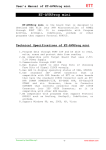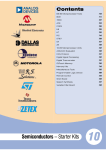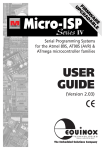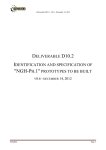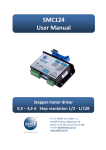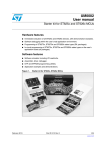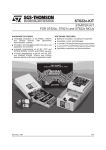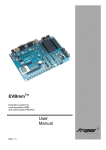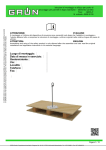Download GrandEVBavr en
Transcript
GrandEVBavr evaluation board for AVR microcontrollers . User’s Manual REV 1.0 u rd ST, ta- rve l a oa , S e Ev B VR ers b S d l n io 1, A trol We mo t i a ‘5 in ron ed r c fo cro dd s M the e s d e i m mb oar rs, peC E B e S PI its ng roll gh r K pi nt Hi fo r y o rte tot roc FID ers s o c r Pr mi s, R mm lle rs or ler gra tro f ol n o s pr oco CB e nt r l u o m icr s, P for c e t t m m ds s e ne Sy T st oar lS n y I , s B ro ed PIC or ion ont b s , c e R ce luat cro W V o A pr va mi ed iro E dd ic ng PIC be ds m M ni T, m r , ig , S s E oa rs s e B t l de VR Ki ng rol h t i r , A rte typ on Hig 1 c ‘5 Sta oto ro ID r e ic F rs P le rs or m s, R mm ve s f ller gra ntrl r Se ule tro pro oco od con ms icr s, m ni net ste T m stem y S y r ohe In S C, r s B t e d PI eso tion ice , e R oc ua m Sp AV opr val IC e r r fo ic g E T, P mb E rs s M nin , S s ing r ig t R i e l ol des , AV er K typ B `51 tart roto roS s P mic , PC for s s ller er for lers d l ar tro erw les tro on b S du con ram c ro We imo et rog o n n p ed Mi her m roc d d ds et ste ic ar rs, Sy T m r o B olle In , S so tr ed IC oce ign P s co Spe R, opr De V cr B Rion h t ig r A Mi PC lua H f o rs , s oneasolution e Many ideas s er roll em Ev ds m nt st ng oar y o c S ni B Contents 1 Introduction ............................................................................................................................................................. 3 1.1 Features ........................................................................................................................................................... 4 1.2 Supported microcontrollers............................................................................................................................. 5 Getting Started ........................................................................................................................................................... 6 2.1 System Requirements .................................................................................................................................... 6 2.2 GrandEVBavr Components ............................................................................................................................ 7 2.3 Quick start ........................................................................................................................................................ 9 2.4 Programming AVR microcontroller ............................................................................................................. 10 3 Hardware description.......................................................................................................................................... 12 3.1 Power supply ................................................................................................................................................. 12 3.2 Microcontrollers sockets .............................................................................................................................. 13 3.3 System clock.................................................................................................................................................. 16 3.4 Port Connector .............................................................................................................................................. 17 3.5 LED’s .............................................................................................................................................................. 17 3.6 Switches ......................................................................................................................................................... 18 3.7 Relays ............................................................................................................................................................. 18 3.8 Buzzer............................................................................................................................................................. 19 3.9 Seven-segment LED Display ...................................................................................................................... 19 3.10 Alanumeric Display ..................................................................................................................................... 20 3.11 Graphical Display ........................................................................................................................................ 20 3.12 Interface UART ........................................................................................................................................... 21 3.13 Interface USB .............................................................................................................................................. 21 3.14 Interfejs LAN ................................................................................................................................................ 22 3.15 I2C connector .............................................................................................................................................. 22 3.16 1WIRE interface ........................................................................................................................................... 23 3.17 Driver ............................................................................................................................................................ 23 3.18 PS2 interface ............................................................................................................................................... 24 3.19 FLASH Memory........................................................................................................................................... 24 3.20 EEPROM Memory ...................................................................................................................................... 24 3.21 SRAM Memory ............................................................................................................................................ 25 3.22 Additional logic gates ................................................................................................................................. 25 3.23 Pole prototypowe ........................................................................................................................................ 26 3.24 Prototipe board socket ............................................................................................................................... 27 3.25 Potentiometers ............................................................................................................................................ 27 3.26 LM35 Tehrmometer .................................................................................................................................... 28 3.27 Photoresistor ............................................................................................................................................... 28 3.28 Real Time Clock DS1307 ......................................................................................................................... 29 3.29 Digital – Analog & Analog – Digital Converters ..................................................................................... 29 3.30 Infrared transmitter and receiver .............................................................................................................. 30 4 Jumpers and Shorts description ..................................................................................................................... 31 4.1 Connectors ..................................................................................................................................................... 31 4.2 Jumpers .......................................................................................................................................................... 35 4.3 LED’s & buttons ............................................................................................................................................ 35 5 Troubleshooting Guide ...................................................................................................................................... 36 6 Dane techniczne ................................................................................................................................................... 37 7 Technical Support................................................................................................................................................ 38 8 Example Application ........................................................................................................................................... 38 9 Schematic .............................................................................................................................................................. 38 Warranty Statement ............................................................................................................................................ 38 1 1 Introduction The GrandEVBavr is an Evaluation System. It was created to support You in building systems based on Atmel AVR microcontrollers. This flexible base will allow You to create and verify projects and "shark ideas" quick and easily. Our remedy idea "many ideas one solution" was implemented in this project. That is the reason why we've created Evaluation System, able to handle most of AVR microcontrollers in DIP or SMD (with special adapter) package (all adaptors are available at www.propox.com). Board was designed to give an access to all of the MCU ports (available on gold-pin connectors). Grand EVBavr include very flexible set of peripheral devices and extension connectors. In our opinion this set is great to start Your life with AVR as well as journey in the FABULOUS WAY to Your advanced designs and projects. The list of peripherals starts from simple relays, LED diodes or Buzzer and goes to USB interface and SRAM memory. The most experienced users can build embedded units which can be equipped in Ethernet. That is why we've designed GrandEVBavr to support PROPOX LAN module (MMlan02). List of interesting peripherals: LM32 thermometer, 2 relays, 2 potentiometers, reference power supply, adjustable reference voltage, ADC and DAC converters, RTC clock, EEPROM memory, FLASH memory, SRAM memory, four 7-segment displays, 8-channel driver, PS2 connector (keyboard or mouse or some of Your ideas), photoresistor, IR transmitter and receiver, USB interface, UART interface, 1Wire connector, I2C connector. The most interesting are options provided by our evaluation board: common 2x16 alphanumeric display, graphical display(controller T6963C) or PROPOX LAN interface (MMlan02). All the system of GrandEVBavr is prepared to support ETHERNUT NutOS, and of course :) The most important for us users all available at All that peripheries are easily available on standard gold-pins connectors. The Power supply solution? We did it for You. On a board is placed bridge and voltage regulators, so what will You need to provide power to GrandEVBavr? Just a basic AC form DC Power supply, the polarisation of supply will be checked and connected automatic by GrandEVBavr. We thought about "masters of designs" bright and clever users, that is the reason why GrandEVBavr provide the prototype field and extension connector. We wish great success and full satisfaction while designing and constructing appliance bases on GrandEVBavr. 1.1 Features • • • • • • • • • • • • • • • • • • • • • • • • • • • • • • • • • • • • Sockets for many kinds AVR microcontrollers . ISP (In-System Programming) connectors JTAG connectors for OCD (On-Chip Debugging) All I/O ports easily accessible trough pin header connectors Base regulated power supply VTG for 1.25 to 5V Regulated precise source of reference voltage VREF Sockets for crystal oscillator External oscillator RC 8 micro switch and 8 LED for general usage Buzzer Light detector (photo resistor) 2 relays 2 potentiometers Thermometer LM35 witch voltage output Infrared transmitter and receiver Ethernet Interface Module LAN (1) USB Interface Port RS232 for general usage Eight channel driver PS2 socket for mouse or keyboard 1-Wire connector I2C connector Alphanumeric display - 2x16 chars Four 7-segment LED display Graphic display 128 x 64 pixels (1) I2C Real Time Clock with Lithium Battery I2C digital to analog (D/A) and analog to digital (A/D) converter External 128kB SRAM memory with address latch Serial SPI Flash memory with capacity up to16-Mbit (2) EEPROM I2C memory with capacity up to 256 kB (2) Additional CMOS logic gates Prototyping Area Extension slot (PC/ISA standard) for extension cards and prototype boards Test points for VTG, VADJ, VREF, AGND Segregation of masses, digital GND and analog AGND Easy configuration of the system using straps (1) Installed depending on version GrandEVBavr (2) Optional 1.2 Supported microcontrollers GrandEVBavr let You to programmer and test AVR Atmel microcontrollers, starts form easies ATiny in DIP8 package, ends on the most advanced ATmega series in TQFP100 package. The part inserted in the socket can be programmed in the system trough ISP or JTAG (if accessible). Many kind microcontrollers is available in DIP packages, and for them dedicated are sockets SOC1 to SOC7.. Because, advanced microcontrollers to be found only in SMD packages, for them dedicated are special adapters inserting in the sockets SOC8 and SOC9. • • • • • • • • • • • • • • • • • • • • • • AT90CAN128 AT90CAN128 Automotive AT90CAN32 AT90CAN32 Automotive AT90CAN64 AT90CAN64 Automotive AT90S1200 AT90S2313 AT90S2323 AT90LS2323 AT90S2333 AT90LS2333 AT90S2343 AT90LS2343 AT90S4434 AT90LS4433 AT90S8515 AT90S8535 ATmega103 ATmega103L ATmega128 ATmega128L • • • • • • • • • • • • • • • • • • • • • • • • • ATmega1280 ATmega1280V ATmega1281 ATmega1281V ATmega16 ATmega16L ATmega162 ATmega164P ATmega168 ATmega168P ATmega2560 ATmega2560V ATmega2561 ATmega2561V ATmega32 ATmega32L ATmega323 ATmega323L ATmega324P ATmega328P ATmega48 ATmega48P ATmega64 ATmega64L ATmega640 • • • • • • • • • • • • • • • • • • • • • • • • • ATmega644 ATmega603 ATmega603L ATmega644P ATmega64RZAPV ATmega64RZAV ATmega8 (L)!!! ATmega8515(L)!!! ATmega8535(L)!!! ATmega88 ATmega88P ATtiny12 ATtiny13 ATtiny15L ATtiny2313 ATtiny24 ATtiny25 ATtiny26 ATtiny261 ATtiny44 ATtiny45 ATtiny461 ATtiny84 ATtiny85 ATtiny861 2 Getting Started GrandEVBavr Evaluation System is included with parts like below: • • • • • • • • GrandEVBavr board (1 pieces) Power supply (1 pieces) ISPcableIII programmer (1 pieces) CD witch example software (1 pieces) IDC10 cables for connection on board (2 pieces). 10-wires cables for I/O ports (2 pieces) 1-wire cable (10 pieces) Jumpers (10 pieces) 2.1 System Requirements • • • • • • • • Processor 400Mhz (Pentium recommended) 256 MB RAM 50 MB free space on HDD Windows 98, Windows NT 4.0, Windows 2000, XP or higher LPT Printer port (Centronics) (1) RS232 port (115200 bauds) (2) USB Port (3) Power Supply 9-12 DC or 7-9 AC min.750mA (4) Note: 1: 2: 3: 4: Version with ISPcable I Programmer Version with ISPcable II Programmer Version with ISPcable III Programmer Version without power supply 2.2 GrandEVBavr Components 1. ISP and JTAG Connectors 2. PS2 Connector 3. USB Interface 4. LAN Interface (option) 5. RS232 Interface 6. Eight Channel driver 7. Relays Connectors 8. Power Connector for AC or DC Power Supply 9. Prototype Area 10. Variable Voltage Source 11. Reference Voltage Source 12. Potentiometers 13. Power Switch 14. Buzzer 15. Switches 16. LED’s 17. Four 7-segment LED display 18. LM35 Thermometer 19. Infrared Receiver and Transmitter 20. Photoresistor 21. 1-Wire Connector 22. RESET switch 23. Sockets for microcontrollers 24. FLASH Memory 25. Crystal oscillator 26. Extension slot (PC/ISA standard) for extension card 27. CMOS logic gates 28. SRAM Memory 29. All I/O ports available on the board 30. EEPROM memory 31. Real Time Clock DS1307 32. LCD display (option) 33. Graphic display 128x64 pixels (option) 34. Converter A/C and C/A 2.3 Quick start The GrandEVBavr starter kit is shipped with ATmega128 microcontroller mounted in ADPmega adaptor in socket marked SOC8. The default jumper settings will allow microcontroller to execute test program from the clock source (internal oscillator 1MHz) and voltage regulator (VTG=5V) on the GrandEVBavr board. Connecting programmer to correct header, placed close to the back edge of the board. For ATmega128 and ISP programmer is “ISP SOC8” connector. Connection for other microcontrollers is described on Chapter 3. Connect the power supply to power connector (8). Next, turn on the POWER switch (13) . The red LED is lit when power is on. An external 7…12V AC, or 9…15V DC power supply with standard power jack (2.1mm bolt diameter) is required. The input circuit is a full bridge rectifier, and the polarity of the input voltage can be selected either positive or negative center connector. Figure 1. Connection of programmer The microcontroller is programmed with a test program toggles LEDs when the button pressed. Use the supplied 10-pin ribbon cables to connect the header marked “PORT F” with the header marked “LED” and connect header marked “PORT C” with the header marked “KEY”. The connection are shown in Figure 2. Figure 2. Default setup of GrandEVBavr Before turn on POWER switch, make sure the microcontroller is properly inserted and the notch on the microcontroller matches the notch on the socket. 2.4 Programming AVR microcontroller ISPcableIII programmer is seen like STK500 by AVRStudio environment. Configuration and other parameters are included in ISPcableIII user manual. First step after start AVRStudio is choosing type of microcontroller. Pressing buton, will start user interface as shown on Figure 3: Figure3. User Interface AVR Studio A device is selected by selecting the correct device from the pull-down menu. This group also includes a button that performs a chip erase on the selected device, erasing both the flash and EEPROM memories. Load input .hex (i.e. example1.hex) file to Flash Memory. Browse to the correct file by pressing the button or type the complete path and filename in the text field. Next push Program button. For more information, can be found in manual of Propox programmers. Caution ! Be careful setting fuse bits. Disable RESET or „ISP programming” not allowed programming devices! 3 3 Hardware description 3.1 Power supply Four voltage sources on the board is available : 1) 2) 3) 4) +5V regulated Variable from 1.25V to 5V Reference voltage VREF variable from 0 to 5V VCC DC voltage from external power supply Fixed +5V voltage is obtained from LM7805 standard IC regulator. Can be used to supply microcontroller and peripheries such as character LCD, graphic LCD and LAN module. Maximum output current is 600mA. LM317 voltage regulator can supply the variable voltage VADJ. from 1.25V to 5V. VADJ can be adjusted trough VADJ. potentiometer (P1). Maximum output current is 600mA. Reference voltage VREF, is produced by circuit with OP07 and LM285 devices. VREF can be adjustable trough VREF(P2) potentiometer between 0 and 5V. Reference voltage AREFuC supply on-chip A/D converters, is obtained with VREF source when the jumper is mounted. Voltage Target VTG supply microcontroller and peripherals is selected between +5V source (+5V jumper position) and VADJ source (VADJ position) on VTG SEL. header. Additionally test points placed close to right edge of board, allows to easy measure and control voltage. On the board is many places with VTG,GND and +5V connector, allows connect external devices. Figure 4. VREF and VADJ supply 3.2 Microcontrollers sockets Microcontroller inserted in the dedicated sockets can be programmed in the system trough ISP or JTAG (if accessible) connector. Programming connectors for programmer, is placed close to back edge of board. Microcontroller installed do dedicated sockets (SOCx) on the board (23). Be careful, when inserting a device in the socket. Caution! When inserting a device in the socket, notice the orientation of device! Only one microcontroller should be inserted in the socket at a time! Make sure that implemented AVR microcontrollers not require external crystal. Detailed information on system clock can be found in the appropriate device datasheet. Table 5, shows which socket suits which AVR device, and which target programmer connector to use for ISP or JTAG programming. MICROCONTROLLER SOCKET ISP CONNECTOR JTAG CONNECTOR AT90CAN128 SOC8 ISP SOC8 JTAGSOC8SOC9 AT90CAN128 Automotive SOC8 ISP SOC8 JTAGSOC8SOC9 AT90CAN32 SOC7 ISP SOC7 JTAGSOC8SOC9 AT90CAN32 Automotive SOC8 ISP SOC8 JTAGSOC8SOC9 AT90CAN64 SOC8 ISP SOC8 JTAGSOC8SOC9 AT90CAN64 Automotive SOC8 ISP SOC8 JTAGSOC8SOC9 AT90S2313 SOC4 ISP SOC4 - AT90L(S)2323 SOC1 ISP SOC1 - AT90L(S)2333 SOC5 ISP SOC5 - AT90L(S)2343 SOC1 ISP SOC1 - AT90L(S)4433 SOC5 ISP SOC5 - AT90S8515 SOC6 ISP SOC6 - AT90S8535 SOC7 ISP SOC7 - ATmega103(L) SOC8 ISP SOC8 - ATmega128(L) SOC8 ISP SOC8 JTAGSOC8SOC9 ATmega1280(V) SOC9 ISP SOC9 JTAGSOC8SOC9 ATmega1281(V) SOC8 ISP SOC8 JTAG SOC8 ATmega16(L) SOC7 ISP SOC7 JTAG SOC7 ATmega161(L) SOC6 ISP SOC6 - ATmega162 SOC6 ISP SOC6 JTAG SOC6 ATmega164P SOC7 ISP SOC7 JTAG SOC7 ATmega168(P) SOC5 ISP SOC5 - ATmega168(V) SOC5 ISP SOC5 - ATmega2560V SOC9 ISP SOC9 JTAGSOC8SOC9 ATmega2561V SOC8 ISP SOC8 JTAGSOC8SOC9 ATmega32(L) SOC7 ISP SOC7 JTAG SOC7 ATmega323(L) SOC7 ISP SOC7 JTAG SOC7 ATmega324P SOC7 ISP SOC7 JTAG SOC7 ATmega328P SOC5 ISP SOC5 - ATmega48(P) SOC5 ISP SOC5 - ATmega64(L) SOC8 ISP SOC8 JTAGSOC8SOC9 ATmega603(L) SOC8 ISP SOC8 - ATmega640 SOC9 ISP SOC9 JTAGSOC8SOC9 ATmega644 SOC7 ISP SOC7 JTAG SOC7 ATmega644P SOC7 ISP SOC7 JTAG SOC7 CAUTIONS Require ext. crystal oscillator (connected toPA0 and PA1) Require ext. crystal oscillator (connected toPB3 and PB4) Require ext. crystal oscillator (connected to PB6 and PB7) Require ext. crystal oscillator (connected to PB6 and PB7) Table 5. Microcontrollers and dedicated programming connectors MICROCONTROLLER SOCKET ISP CONNECTOR JTAG CONNECTOR ATmega64RZAV SOC7 ISP SOC7 - ATmega64RZAPV SOC7 ISP SOC7 - ATmega8(L) SOC5 ISP SOC5 - ATmega8515 SOC6 ISP SOC6 - ATmega8535 SOC7 ISP SOC7 JTAG SOC7 ATmega88(P) SOC5 ISP SOC5 - ATtiny12 SOC1 ISP SOC1 - ATtiny13 SOC1 ISP SOC1 - ATtiny15L SOC1 ISP SOC1 - ATtiny2313 SOC4 ISP SOC4 - ATtiny24 SOC2 ISP SOC2 - ATtiny25 SOC1 ISP SOC1 - ATtiny26 SOC3 ISP SOC3 - ATtiny261 SOC3 ISP SOC3 - ATtiny44 SOC2 ISP SOC2 - ATtiny45 SOC1 ISP SOC1 - ATtiny461 SOC3 ISP SOC3 - ATtiny84 SOC2 ISP SOC2 - ATtiny85 SOC1 ISP SOC1 - ATtiny861 SOC3 ISP SOC3 - CAUTIONS Pin PB3 and PB2 are swap Table 6. Microcontrollers and dedicated programming sockets (cont.) 3.3 System clock Microcontroller can be operated with external crystal oscillator or RC oscillator. Sockets for crystal oscillator allows applicable crystal from 32kHz to 16MHz. For devices with dedicated XTAL1 and XTAL2 pins only for crystal (i.e. Atmega128), only need to short jumper XTAL1 and XTAL2. Figure 7. External system clock Figure 8. System clock Jumper RC allows connected external RC oscillator to microcontroller. User may install precision clock oscillator (XO) close to crystal oscillator. When use of clock oscillator, jumper XO must be shorted. When use RC or XO, jumpers XTAL1 and XTAL2 must be removed. 3.4 Port Connector All microcontroller I/O ports are available on the headers marked from A to L. That, what ports are available depends what microcontroller is being using at the moment. Ports are connected with peripherals using peripheral cables like on Figure 9. Figure 9. Connection of 1-wire cable between port and peripheral devices 3.5 LED’s The board has 8 LED diodes, which make the simplest interface between the system and the user. This is especially useful for the beginners, who want to manipulate or debug their program with different hardware configurations. The diode turns on after grounding of the associated Ldn (n = 0 – 8). Figure 10. Implementation of LED 3.6 Switches Eight switches is available on the board. Pushing a switch causes the corresponding SWx to be pulled low, while releasing it will result in VTG on the appropriate switch header connector. Figure 11. Implementation of Switches and Switch Headers 3.7 Relays Two relays controlled by transistor are available on the board. Bases of transistors are connected to REL1 and REL2 pins RLY header, and pins: NC,NO,COM of the relay terminal block on the rear edge of the board. Logic level 0 applied to the RELx pin, will activate the relay. External circuits can be controlled via NC, NO, COM I/O pins. Led indicate activated relay. Figure 12. Implementation of relay 3.8 Buzzer The board has an acoustic indicator turned on and off by the transistor. The base of the transistor is connected to the BUZZ pin of the MISC header. Logic level `0` applied to the SPK pin, will activate the buzzer. Figure 13. Implementation of buzzer 3.9 Seven-segment LED Display The board is equipped with four 7-segment led display. They make an interface between the system and the user, allowed to display up to four chars. Each led display has two anodes, seven segments and DP (digital point), which become active after applied to their pin logic level ‘0’. Figure 14. Implementation of 7-segment LED 3.10 Alphanumeric LCD Display The board has one alphanumeric LCD display with HD44780 interface. The LCD connector has four data lines and two control lines: strobe line E and control line R/S. The display R/W line is permanently connected to ground; all other lines are available at the pin header. The adjustment of contrast may be done by two way: • • By CONTRAST potentiometer with shorting VC and CTR By microcontroller Backlight is turned on by host LTG pin to high level. Figure 15. Alphanumeric Display connector 3.11 Graphic Display On board is placed LCD AV-G12864B1-A601-R 128x64 with T6963C interface connector. This display has embedded character table. On connector are placed control signals C/D, /CD and FS. 8-bit data Line is connected to common data line with SDRAM memory and LAN on HDR PA[7..0] connector which is connected to A port of microcontroller. Backlight may by turn on by shorting LTG with high state. The adjustment of contrast may be done by CONTRAST potentiometer (R58). Jumper /RST GLCD is connecting display reset with system reset. Figure 16. Graphic Display connector 20 3.12 UART Interface On board is place DB-9 connector with ST3232 logic converter unit. Signals form logic converter are connected to gold-pin connector which allow user to connect them to microcontroller. Figure 17. UART Interface Implementation 3.13 USB Interface On board is placed USB interface using FTDI FT232RL chip. Jumper JP38 is using to choose high state level (3.3V or 5V). Figure 18. USB interface implementation 21 3.14 LAN Interface On board is placed connector for LAN module – MMlan02 producing by PROPOX. 8bit data signal is connect to half of HDR_PA[7..0] connector. Other signals are available on LAN connector. Figure 19. LAN Module Figure 20. LAN connector 3.15 I2C Connector This connector allow to connect unit which are using I2C interface, like EEPROM memory, RTC clock DS1307 or ADC and DAC converters. Figure 21. I2C connector 22 3.16 1-WIRE Interface On board is placed 1-Wire connector which allow to connect DS18S20 Digital Thermometer or other units which are using this type of interface to communication. Rysunek 22. 1WIRE connectors Figure 23. Connection of DS18S20 Digital Thermometer 3.17 Driver That Driver allow to connect units which needs higher current. We can connect some relays, step motors or other units with 12V power supply. We have to remember to do not overdraw current above 0.5A. Additionally is placed connector to four-phase step motor. Figure 24. ULN2803 Driver Implementation 23 3.18 PS2 Interface Allow connected mouse or keyboard via PS2 connector. Figure 25. PS2 connector 3.19 FLASH Memory On board is placed Data Flash memory AT45DB041B – 4MB. It is using SPI interface to communication. WP (Write Protect) signal do not allow to write to memory or erase memory, by sending low level signal. VF signal allow to connect power supply between 3.3V and 5V. Figure 26. Flash Memory Implementation 3.20 EEPROM Memory EEPROM memory 24C08 placed under graphical display is communicating by I2C interface. Figure 27. EEPROM Memory Implementation 24 3.21 SRAM Memory Is placed 128kB SRAM memory with lath unit 74AHC573. Control signals are available on connectors: A-W-R , EnSRAM and HI ADR. Data and address signals are placed on HDR PC[7..0] and HDR PA[7..0] connectors. Figure 28. SRAM Memory A-W-R – are available signals ALE, WRITE and READ EnSRAM – Enable SRAM HI ADR – memory banking When is placed jumper on A15 SRAM and address line – is used only 64kB memory space. 3.22 Additional Logic Gates On board are placed CMOS Logic Gates units: 74AHC00, 74AHC30, 74AHC32, 74AHC138. It allows to build gating unit or SRAM addressing. Power supply is form VTG. Every inputs and outputs are placed on gold-pin connectors. 25 Figure 29. CMOS Logic Units 3.23 Prototype field This prototype field allow to implement additional units and modules. Near this field are placed VTG, 5V and GND lines. Holes allow to place above this field additional prototype board PX22 with dimension 60x100mm. Figure 30. Prototyping Field 26 3.24 Prototype board socket GrandEVBavr have socket for prototype card. It is compatible with PC XT/AT (ISA). All signals are available on gold-pin connectors. Figure 31. Prototype Card 3.25 Potentiometers The board is equipped with two potentiometers, allowing for simulation of the analog circuit outputs. Potentiometer enables the adjustment of voltage in the range 0 - VTG. The potentiometers outputs are accessible on the POT1 and POT2 pin of the ANALOG header. Figure 32. Potentiometers 27 3.26 LM35 Thermometer It allow to measure environment temperature and display it by example on 7segment displays. Vout voltage is proportionally to temperature. It is available on ANALOG connector under TEMP name. Figure 33. LM35 Implementation 3.27 Photo resistor It allow to measure light strain. Output voltage is changing for about 0,95V (light) to about 3,4V (dark). It is available on ANALOG connector under FOTO name. Figure 34. Photo resistor Implementation 28 3.28 Real Time Clock DS1307 Board has placed RTC clock with backup battery (CR2032 3V). It is using I2C interface to communicate with environment. Figure 35. RTC clock Implementation. 3.29 Digital – Analog & Analog – Digital Converters Board have 8-bit, 4 channel ADC converter and DAC PCF8591 converter. It is using I2C interface to communicating. All inputs and outputs are placed on gold-pin connector PCF&MISC. . Figure 36. DAC and ADC converters implementation Jumper Vref ADC DAC feed target voltage VTG, on the reference voltage input VREF PCF8591 device. Instead jumper we can connecting voltage reference source. 29 3.30 Infrared transmitter and receiver On board is placed IR receiver TFMS5360(TSOP1236) which is working on 36kHz and IR transmitter diode with wave length 880nm. It allow to build IR transceiver. Figure 37. Implementation infrared transmitter and receiver. 30 4 4 Header and Connectors 4.1 Connectors LED’s & Switches Header LD0...7 – diodes SW0...7 – micro-switches 7-segment LED Header A0...A3 – Anodes Supply A,B,C,D,E,F,DP – Segment Supply (description on the board) Relay Connector REL1 – RELAY1 control pin REL2 – RELAY2 control pin NO – Normal Open NC – Normal Close CON – Common 31 CLCD Character Display Header +5V – +5V Voltage LTG – Backlight Display pin control VC – Contrast Potentiometer Output Voltage CTR –LCD Contrast line R/S – Control line LCD data/command E – strobe line LCD DB4,DB5,DB6,DB7 – data line GLCD Graphic Display Header LTG – Backlight Display pin control +5V – +5V Voltage /CE – Chip Enable (low active) GND – Ground C/D – Command/Data Line FS – Font Select ANALOG Header DAC OUT – Output Digital-Analog Converter PCF8591 AGND – Analog Ground Converter PCF8591 ADC CH1 – Input 1 Analog-Digital Converter PCF8591 TEMP – LM35 voltage output ADC CH2 – Input 2 Analog-Digital Converter PCF8591 FOTO – Photo resistor Voltage Output ADC CH3 – Input 3 Analog-Digital Converter PCF8591 POT1 – Potentiometer Voltage Output ADC CH4 – Input 4 Analog-Digital Converter PCF8591 POT2 – Potentiometer Voltage Output I2C Header SDA – I2C data line SCL – I2C clock line RTC Header VBAT – pin with battery voltage FT – Real Time Clock operation correction line 32 MISC Header TX IR – Infra Red input data BUZZ – buzzer RX IR – Infra Red output data 1WIRE – 1-Wire output pin LAN Header CS – Strob Line LAN module RST – Reset LAN module (activ hi level) A4,A3,A2,A1 – Address Line INT – Interrupt Line FLASH Header VF – FLASH supply voltage +5V – +5V Voltage WP – Write Protect Memory GND – Ground CS – Strobe Line SCK – SPI Clock Line SO – SPI Outputs Data SI –SPI Inputs Data DRIVER Header GND – Ground VTG – Target Voltage D1..D8 – Driver’s inputs DRIVER OUT Connector D1..D8 – Output driver VCC – Driver supply 33 ISP Programmers Connector GND – Ground VTG – Voltage Supply PB6 – Data Input Line MISO PB7 – Programmator’s clock line SCK RESET – RESET Line LED – Line connected witch diode LED. During programming the diode is lightning PB5 – Programator’s output data line MOSI JTAG Programmers Connector PC5 – TDI (Test Data In) Line PC4 – TDO (Test Data Out) Line PC3 – TMS (Test Mode Select) Line PC2 – TCK (Test Clock) Line RST – Reset Line VTG – Voltage Target GND – Ground 34 4.2 Jumpers Jumpers Function Jumper J1 J2 Short – connect oscillator to XTAL1 and XTAL2. Jumper J3 have to be short. Jumper J3 Short – connect RC oscillator to XTAL1. Jumpers J1 and J2 have to be open. Jumper Vref 2.5V Short – reference voltage 2,5V. Open – reference voltage 4,5V. Jumper AREF SEL. Fixed – AREF = VREF. Var – AREF can be changing between 0V and VREF. Jumper VTG SEL. 5V – power supply is +5V VAR – power supply can be changing. Jumper Vref ADC, DAC Short – reference voltage of ADC is equal to VTG. Jumper /RST GLCD Short - /RST of GLCD is short to system reset. Jumper JP38 It sets power supply of USB unit. Choosing between 5V and 3,3V. 4.3 LED’s & buttons Name Function POWER led The RED Led is directly connected to the +5V supply. The power led is always lit when power is applied to GrandEVBavr RESET The RESET push button resets the target AVR Device when pushed. 35 5 5 Troubleshooting Guide Table 2 Problems Problem Reason Solution Supply cable not connect. Connect supply cable. Wrong supply power. Power switch off. ATmega128 is not on his place. Check power supply. Turn on power switch. Check ATmega128. Connect diodes to ports. UART serial communication does not work properly LED diodes are not connect to microcontroller’s ports. Signals RxD and TxD are not connect to microcontroller’s ports. Connect signals to ports. RTC does not work properly I2C signals are not connect to microcontroller’s ports. Wrong jumpers settings. Check jumpers settings. Wrong connection of ALCD signals to ports. Check configuration. ISP cable connect wrong. Check cable. Microcontroller placed wrong. Check microcontroller. Wrong oscillator or J1 J2 J3 jumpers settings. Check oscillator and jumper settings. The red power LED is not on Example code does not toggle the LEDS Connect signals to ports. SRAM does not work properly ALCD does not work properly ISP device cannot be programmed 36 6 6 Technical Data System unit: Dimensions board: Weight: Operating Conditions Supply voltage DC (VDC): Supply voltage AC (VAC) Max. Current POWER (Izas): 30cm x 30cm c.a. 650g 9-15V DC 7-12V AC 1.5 A @ VDC 9V or VAC 7V 1A @ VDC 12V or VAC 9V 700mA @ VDC 15V or VAC 12V Base voltage VTG: Max. current (Ivtg): Voltage +5V Max. current (I5v): 1,2 – 5V DC 1.0 A but not greater then Izas 5V DC 1 A but not greater then Izas VREF voltage Max. current VREF voltage drift XTAL frequency `range +2,5V or +4,5V 15mA or 100mA max. 80ppm 32kHz – 24MHz Connectors: Power Connector UART Connector RS232 USB Connector LAN Connector Extension Slots Connector : 5.7mm x 2.1mm 9 (D-SUB) female USBB female RJ45 female PC XT/AT (ISA) 37 7 7 Technical Support For technical support, please contact [email protected]. When requesting technical support, please include following information: • Version number of GrandEVBavr • Complete target device part number • Programming voltage • Jumper settings • A detailed description of the problem 8 8 Example Application Examples programs are available with ordered Evaluation System. 9 9 Schematic Full schematics are available with ordered Evaluation System. 10 Warranty Statement GrandEVBavr warranty is for six month. Repair will be completed at no cost to user if user has not caused failure. User is responsible for shipment charges. Limitation and Liability Although all the information contained herein have been carefully verified, Propox assumes no responsibility for errors that might appears in this document, or for damage to things or persons resulting from technical errors, omission and improper use of this guide and of the related software and hardware. 38 39








































